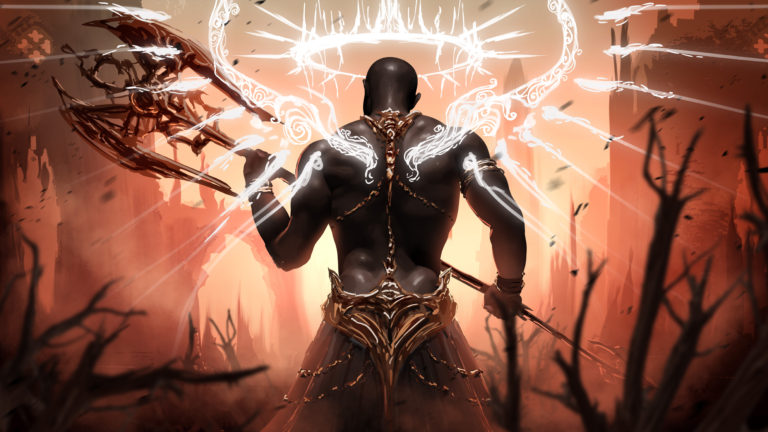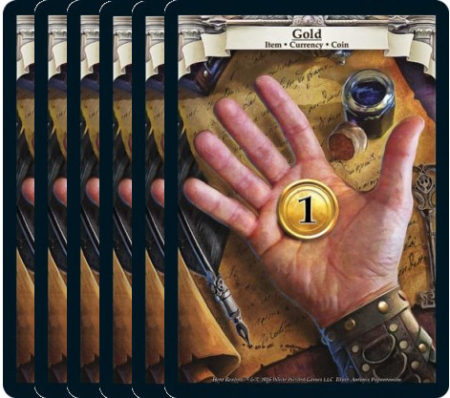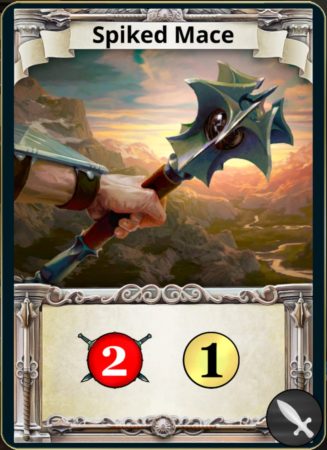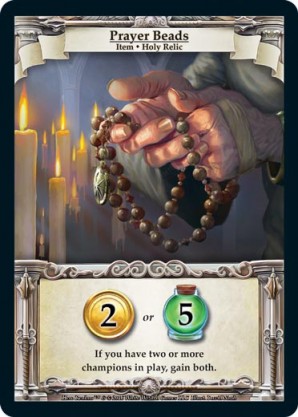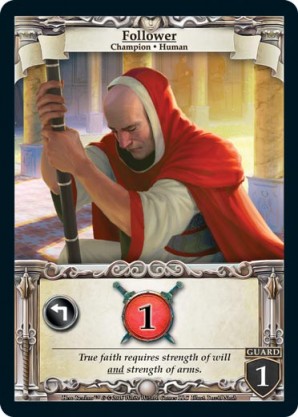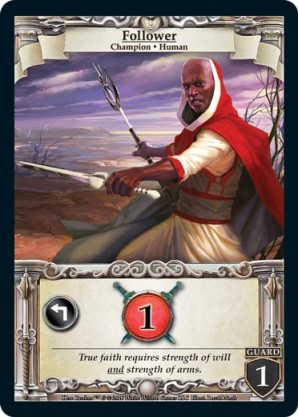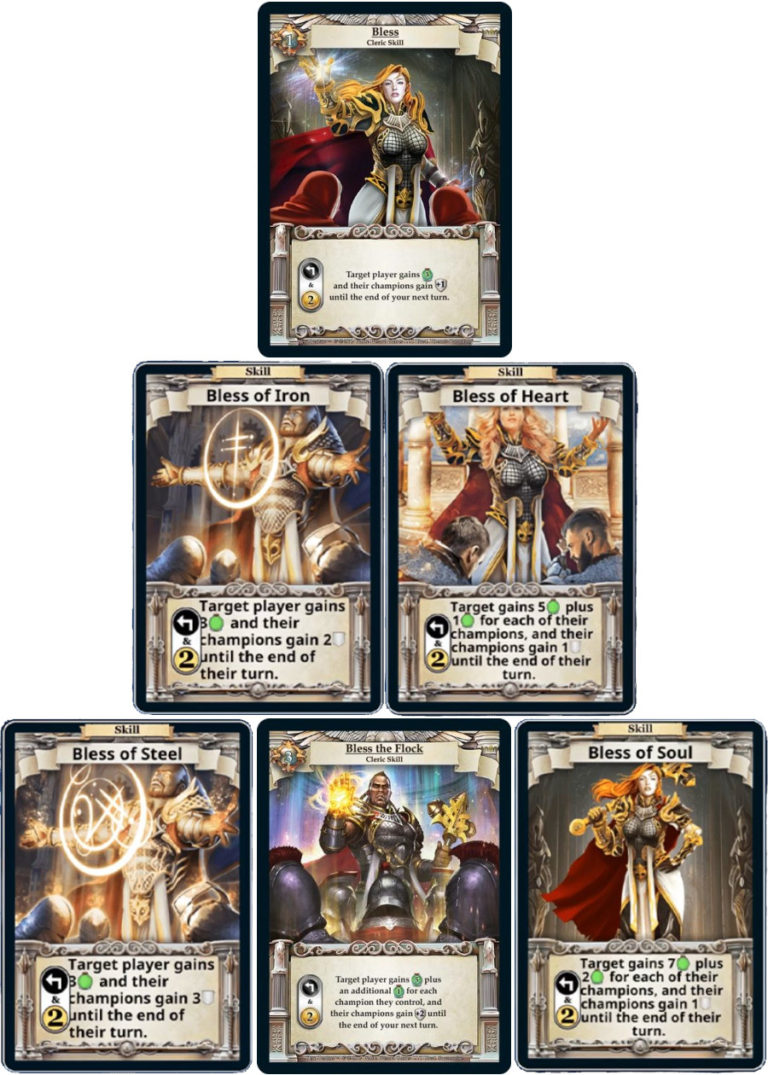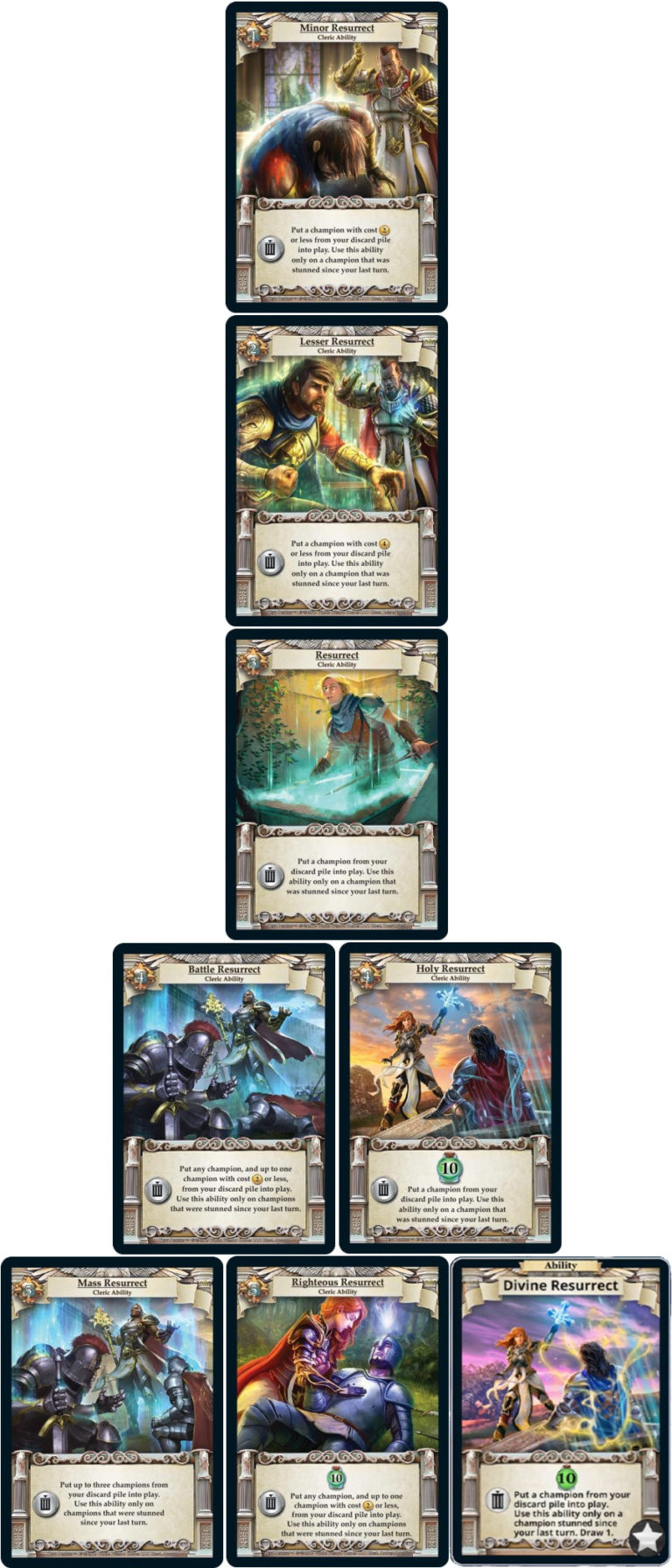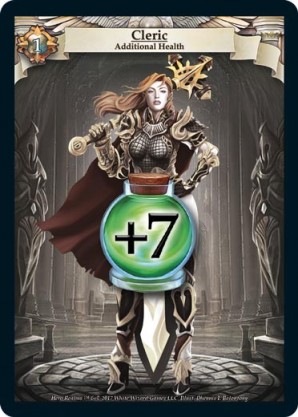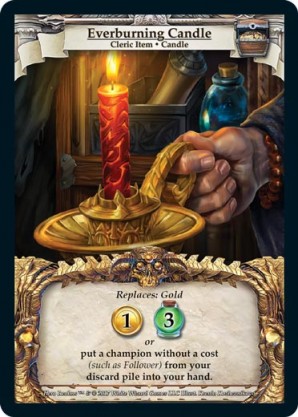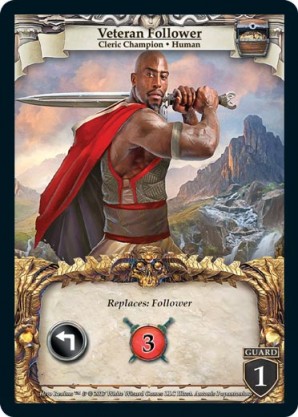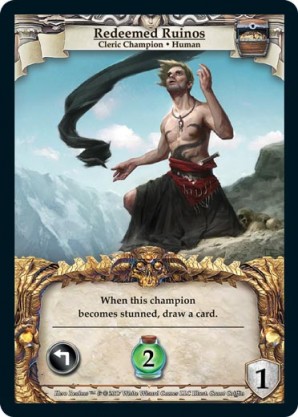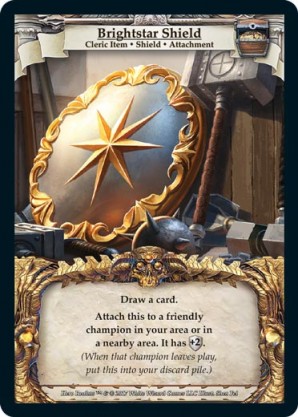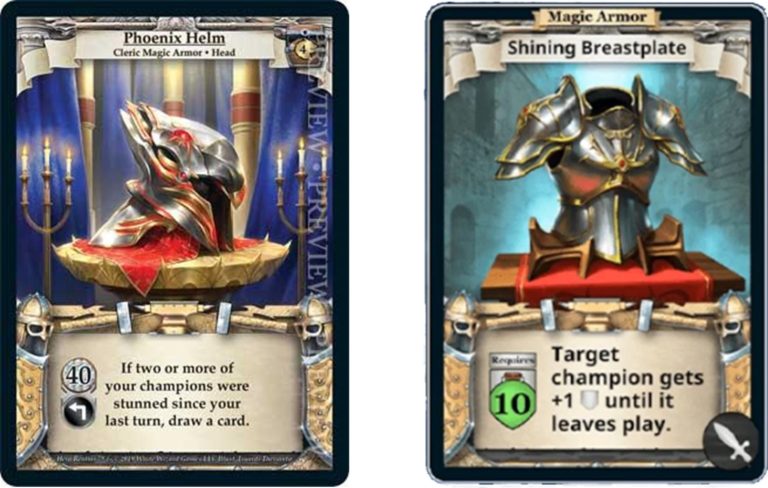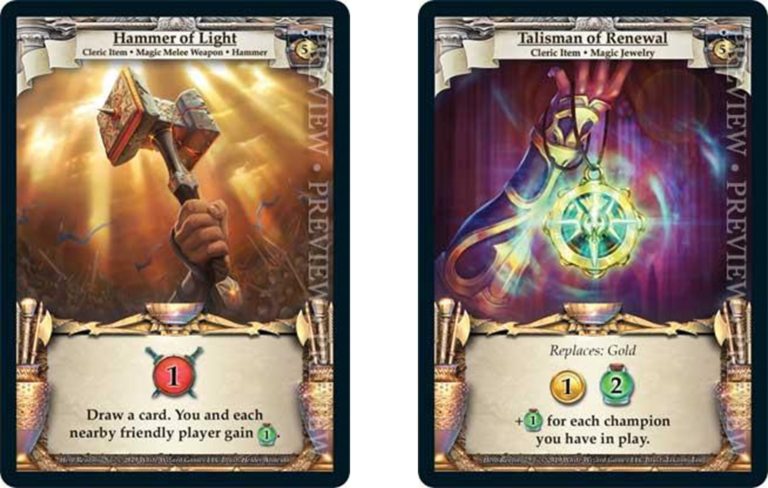Welcome to The Life of the Cleric! This will be a series of articles regarding the Cleric class in the deck-building game Hero Realms created by Wise Wizard Games. We will discuss the Cleric basics, Cleric deckbuilding and matchups, and my suggestions for how to handle decision-making when playing the Cleric. S_Freak has created a nice Overview of Cleric, but this Series is designed to dig a little deeper. Most of our discussion will be presented towards the current beta digital version of Hero Realms. All this knowledge is applicable to the physical card game as well, but expansions and set combinations are required. Knowing that, let’s get started.
First off, let’s go over the base Cleric deck.
- 6x 1 gold
- 1x Prayer Beads (2 gold or 5 heal or both with 2 champions in play)
- 1x Spiked Mace (2 damage +1 gold)
- 2x Follower (Champion with 1 guard and 1 damage)
This starts us off with 9 gold and 4 damage in our starting deck. The 9 potential starting gold is on average compared to other classes. Only the fighter is lower at 8 gold. As for damage, the only real “advantage” if you can call it that, is that 2 of our damage is attached to 2 different champions who can theoretically sit on the playing field for multiple turns, although this rarely happens. Usually, they simply eat up 1 extra damage and then go into the discard pile, which in turn slightly increases our sustain. The 4 damage from starting cards is on the low end compared to other classes.
Cleric also has an exhaustible ability (Bless) and a once per game ability (Resurrect). These can be leveled up over the course of time.
Leveling Up and Upgrades
You start off at level 1 with each class and grow in power as your character levels up. Each level allows for specific upgrades, most of which give you options to choose from. The upgrades at 2 and 3 are automatic, but every other one after that has at least 2 options to choose from. Below is an outline of the upgrades that you will receive at each level.
| Level | Upgrade |
| 1 | Character starts with Minor Resurrect (Put any champion with cost 2g or less from your discard pile into play. Use this ability only on champions that was stunned since your last turn.) |
| 2 | Minor Resurrect upgrades to Lesser Resurrect ((Put any champion with cost 4g or less from your discard pile into play. Use this ability only on champions that was stunned since your last turn.) |
| 3 | Lesser Resurrect upgrades to Resurrect (See further upgrades below) |
| 4 | Upgrade one - Bless/Resurrect/Health |
| 5 | Item Upgrade (Ruin of Thandar Expansion) – Choose from 2 Random Options |
| 6 | Upgrade one - Bless/Resurrect/Health |
| 7 | Item Upgrade (Ruin of Thandar Expansion) – Choose from 2 Random Options |
| 8 | Upgrade one - Bless/Resurrect/Health |
| 9 | Armor Upgrade (Lost Village Expansion) – Choose from 2 Options |
| 10 | Upgrade one - Bless/Resurrect/Health |
| 11 | Item Upgrade (Lost Village Expansion) – Choose from 2 Options |
| 12 | Upgrade one - Bless/Resurrect/Health |
There are a lot of choices here, all of which dictate what tempo your Cleric will play at its best. I highly recommended leveling at least 2 Clerics to learn multiple playstyles and find out what works better and is more fun for you. I’ll make some general recommendations throughout this article but in a later article, I’ll lay out and explain my favorite combinations. For now, let’s go over our skill upgrades.
You start off with “Bless” levels 1-3 and may choose to upgrade from level 4 onwards.
The left side of this tree focuses on buffing champions that are on the board, and the right side focuses on health gain and sustain into the late game. The choice of which tree to choose mostly relies on your playstyle.
If you play a champion-heavy style, Bless of Steel seems like the no brainer choice. There are some things to consider for this style of play, however:, 1) Champions need to be present in the market 2) you may be competing for market champions with your opponent, and 3) you need to deploy multiple champions at the same time to get maximum benefit from your “wall”. This leans more towards a “faster” style of play, but keep in mind that “fast” for the cleric is very relative.
Bless of Soul is the choice if your playstyle frequently pushes you into long games, as it allows for the most amount of sustain. It also provides a lot of flexibility in market choices since it doesn’t need champions to be highly effective.
Bless the Flock is a very nice middle ground as it provides some protection to your champions while also giving you quite a boost to health gain on each use. It’s typically the safer and more flexible of all the options.
You’ll notice in the graphic that there is a “Minor” and “Lesser” Resurrect ability. These are present at levels 1 and 2. They upgrade to “Resurrect” at 3. No choices to be made there.
The left side of this tree fits more into a swarming, mid-range type of playstyle. Whereas the right side of the tree leans more towards a late-game playstyle. I typically tend to pick one that matches the playstyle of which Bless ability I’ve chosen. The left and right side of each ability tree matches each other respectively.
You typically choose Mass Resurrect when you’re trying to drop multiple champions on board and then use your Bless ability to buff the champions up with higher defense. This ability can really swing a game after an opponent clears your board, you resurrect 3 champions back and then add a few more to the board and then buff them. The downside, of course, is that it requires the market to be very liberal with available champions.
On the other side of the tree, you have Divine Resurrect. This is designed to be chosen for those players who typically might be pushing for bigger champions and won’t have the opportunity to resurrect 3 champions very often. They would rather have the extra health gain to sustain in late game plus the extra draw. This could also be used early for the draw option alone to give you that 1 more gold you need to buy a power card, or it could be used to grab that little bit more damage to turn the tide of the battle.
Righteous Resurrect is in the middle. This option is effectively the same as Divine Resurrect but you trade the draw for resurrecting a second champion that costs 2g or less. I find this one to be awkward for me to use but may be situationally more useful than Divine Resurrect. I think I’d almost always prefer the draw as an extra card in hand has the potential to be so much more powerful than a 2g champion.
Health Upgrade
Cleric starts off with a middle of the road 55 Health (the highest being fighter at 60 and the lowest being wizard at 50). The option to upgrade your health by +7 is available as early as the other ability upgrades. In my opinion, it is the least effective of all the upgrades. Yes, in theory, the 7 health could give you that one extra turn to help the tide turn. But in most cases with cleric, if your health has dropped under 10, you’ve already lost control of the game and it’ll be over soon anyways. The only argument that I can find is to pick it up after getting the Phoenix Helm at level 9, due to the high health requirement of Phoenix Helm. But there’s so much life gain in cleric that again, if you have control of the game, keeping above 40 isn’t too much of a task.
Ruin of Thandar Item Upgrades
At level 5, you are offered the 2 item upgrades seen above. Neither of the item upgrades are necessarily bad, but I believe that some are better than others depending on what other items and ability upgrades that you plan on choosing for your character. Everburning Candle and Veteran Follower are upgrades to currently existing cards, so they don’t add any bloat to your base deck.
Everburning Candle is a flexible choice that can be used in a variety of situations.
- Using the 1 gold and 3 heal option allows you to push for that bigger card from the market and give you more healing to sustain into mid and late game.
- Choosing to add a Follower or Ruinos from your discard into your hand can also give you that extra damage that you’re looking for, that extra delayed draw from Ruinos, or it can give you an extra champion to get the “Both” option from Prayer Beads. This can also improve your next shuffle by taking a follower out of it.
All in all, the Candle is a very flexible card but typically combos best when used with either the Veteran Follower upgrade or Redeemed Ruinos.
Veteran Follower is a bit interesting. It’s a bit counter-intuitive to add early damage to a deck that isn’t necessarily looking to push for an early win. But hear me out on the benefits of the Veteran Follower:
- There is a very specific combination of cards and upgrades that can push for “faster” gameplay when playing Cleric. If this is what you are looking for, then take this upgrade.
- There is also an inherent weakness with cleric into later levels when it comes to a lack of damage. This is the one of only 2 available damage “upgrades” in the Cleric kit (the other is available at level 11). If an opponent buys a big health champion in the first round (which happens a lot at later levels), and you don’t have enough damage to deal with it, then it can really set you back a couple of turns and potentially be the defining factor in the game.
At level 7, you are offered the 2 item upgrades seen above. Neither of the item upgrades are necessarily bad, but I believe that some are better than others depending on what other items and ability upgrades that you plan on choosing for your character.
Redeemed Ruinos and Brightstar Shield are added directly to your base deck. This isn’t a big deal since they replace themselves with another draw (either immediately or when it is stunned).
Redeemed Ruinos is a solid choice for a deck looking to push into late game. It does several things:
- It heals you by a small amount each turn that it’s on the field, giving you more sustain into mid and late game
- It gives you an extra card (when stunned) on a later hand allowing you to have 6 cards in hand and hopefully buy a bigger card from the market with more gold or have that extra card to pull off a combo mid/late game.
- It adds another base champion to your deck. Increasing your chances to proc the “Both” option off of your Prayer Beads card more frequently. This can be huge when you look at the potential for extra life gain.
- Your opponent must make a choice. Either they stun it and give you an extra card in hand for that 6 card advantage, or they leave it on the field and accept that you are going to heal an extra 2 every turn. Both are valid choices depending on the circumstances.
Brightstar Shield is the weakest of the options in my opinion. That’s not to say that it doesn’t have a place, but it’s a niche choice.
- It’s best paired with the Veteran Follower to hopefully upgrade its health and then continue to buff it with Bless of Iron/Steel and the Shining Breastplate (Explained later). This is a very Meme-worthy way to snowball into a victory. It feels so good when you can pull it off, and will win you a few games outright, but if you don’t pull off the combo, it’s not quite as good as other combinations of upgrades.
- Adding a “draw a card” to your starting deck also combos well with Guild (Blue) market cards and Varrick.
Lost Village Armor Upgrades
At level 9, you get to choose between two upgrades, Phoenix Helm and Shining Breastplate. Both options are equally viable depending on your strategy.
Phoenix Helm is the best option if your deck is built to sustain above the 40-health requirement. This usually isn’t difficult as cleric. Drawing an extra card after your opponent has wiped your champions can be the difference between recovering with a solid answer and falling behind. It also gives you quite an advantage in the early game when you’re trying to push for those bigger champions from the market. Some opponents may choose to not kill 2 Followers in the first few turns and waste a couple of points of damage just so you don’t get that extra draw, giving you some extra sustain into mid to late game.
Shining Breastplate is usually best paired with Bless of Steel. This can either be with a deck that pushes for that mid-game fight or the meme-win with Veteran Follower and Brightstar Shield. These decks don’t typically heal quite as much and therefore it’s much easier to drop below that 40 health requirement needed for Phoenix Helm. Also, if you don’t have the game in hand with these style decks by the time you drop to the 10-health requirement, you’re most likely going to lose anyways.
Lost Village Item Upgrades
At level 11, you get to choose between two upgrades, Hammer of Light and Talisman of Renewal. Both options are equally viable depending on your strategy.
Hammer of Light is added directly to your deck. It does not add any bloat since it draws a card to replace itself immediately. It effectively adds 1 damage and 1 health gain to your deck. Adding a “draw a card” to your starting deck also combos well with Guild (Blue) market cards and Varrick. Pick this when you plan on playing a more midrange style of deck or you feel like you need more damage in your starting deck.
Talisman of Renewal replaces a gold in your starting deck and activates even more baseline healing to the cleric,which, depending on the upgrades you have chosen and your luck, can be as little as 2 and as much as 5 health each play baseline. That’s quite a lot.
Conclusion
There are a lot of good tools available for the cleric. The difficulty lies in organizing a deck that synergizes well and piloting it. But hopefully this will give you a good start in leading your followers to victory!
